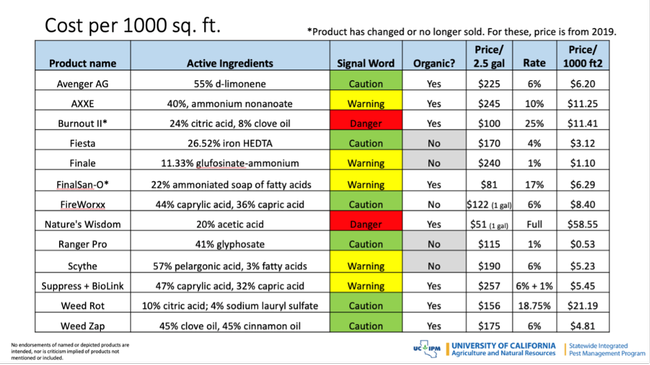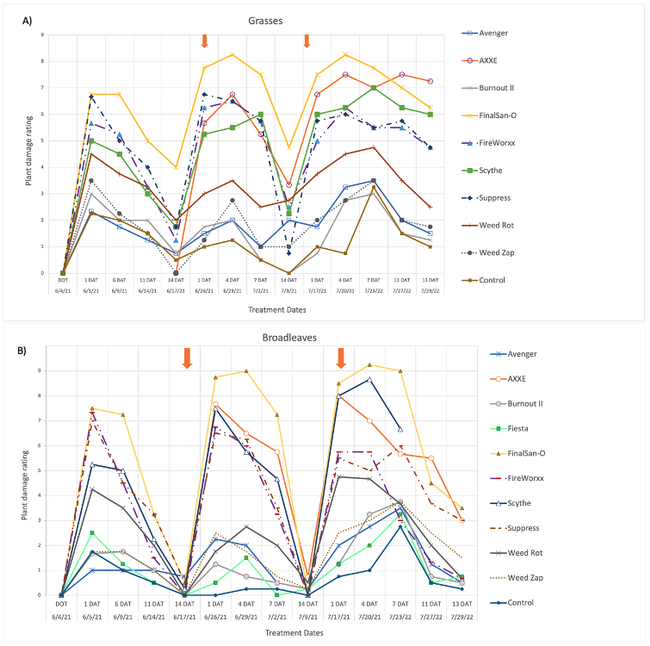Weed management in landscaped areas can be challenging. Weeds may need to be controlled for public safety, fire reduction, aesthetics, and elimination of harborage for other pests. While many nonchemical options for controlling weeds exist—such as physical removal with tools, steam, flame or steam devices, grazing animals, and others—there are some situations that may require the application of herbicides.
For decades, glyphosate has been a common active ingredient used to control weeds in both agricultural and nonagricultural settings. However, there has been significant public concern about the use of glyphosate and other herbicides due to their potential effect on water quality, public health, and non-target species. Because of this ongoing issue, many practitioners have been considering organically-acceptable herbicides as alternative solutions. While some information exists on how organic herbicides work, there is little research on their efficacy in urban landscapes.
Glyphosate vs organic herbicides
Concerns about the potential risks of glyphosate have led to increased use restrictions, including outright professional or municipal use bans in some California cities, counties, school districts, and other sites. Professional landscape managers and other pest management practitioners who aim to reduce or eliminate glyphosate from their IPM programs are therefore seeking alternative products to control weeds.
Organic and alternative herbicides seem like simple substitutes since treatments may not require new application equipment or knowledge. However, knowing the differences in modes of action among glyphosate, organic herbicides, and other alternatives is important to ensure weed management goals are reached.
Organic herbicides may not have the same qualities and performance practitioners have become accustomed to seeing with glyphosate and other conventional herbicide products. For instance, organic herbicides work on contact as opposed to glyphosate, which moves through the entire plant. These organic contact herbicides are most effective at higher temperatures (80°F and higher) and in full sun. Since they work on contact, they are applied after emergence and work best on small annual weeds. For larger or perennial weeds, organic herbicides generally will only damage or burn the top growth of the weed and, after a couple of weeks, the weeds regrow. From the data presented below, regular repeated applications of these products may still be useful tools within an overall IPM program.
Herbicide trials
The research presented here was designed to address the need for glyphosate alternatives by providing information about organic herbicide efficacy. These trials build on previous work by other researchers examining organic and alternative herbicides in non-agricultural settings (see references).
Trials included mostly organically acceptable materials as well as selected non-organic but naturally-derived products. Experiments were performed on the campus of the California State University, Sacramento (CSUS) in summer months of 2019 and 2021. The research site received little foot traffic, was regularly irrigated, mowed, and largely shaded underneath trees for most of the day. Weeds present at the site were a mixture of broadleaves, grasses, and sedge with predominant species being broadleaf plantain (Plantago major), dandelion (Taraxacum officinale), wild strawberry (Fragaria vesca), bermudagrass (Cynodon dactylon), and clovers (Trifolium spp.).
Slightly different products were used between the 2 research years. There were 10 or 11 herbicide treatments along with an untreated control (Table 1). All organic products in the experiment are post-emergent, nonselective, contact herbicides except for the iron HEDTA product (Fiesta), which is selective for broadleaves only. Weed damage was rated by visual inspection using an index (scale) from 0 (no observable plant injury) to 10 (complete plant injury above ground). This damage is referred to as burndown (Figure 1).
Preliminary results
Many products showed rapid plant damage on both grasses and broadleaves on the first day after treatment (DAT). Figure 2 shows results from the 2021 trial, which included results similar to those observed in 2019 and other trials. It was observed that by 3 DAT, ammoniated soap of fatty acids, pelargonic acid + fatty acids, ammonium nonanoate, and caprylic acid + capric acid showed the best control of both grasses (A) and broadleaf (B) weeds in the plots. Products containing citric acid + clove oil, d-limonene, and clove oil + cinnamon oil did not perform well in this trial even after a second treatment.
The iron HEDTA product targets broadleaf weeds only, so it is not included in the chart illustrating grass weed control. Acetic acid (Danger signal word) was not included in the 2021 experiments due to the risk of application to bystanders at CSUS. One product containing acetic acid is included in Table 1 for cost comparison of various alternative herbicide products.
In general, most weeds began to regrow or recover about 2 weeks after treatment. Multiple successive treatments were made after regrowth was observed (around 3 weeks). Efficacy of most products had declined and weeds once again showed regrowth 17 days after the second treatment (Figure 2).
Some of the organic herbicides tested exhibited quick results, with immediate burndown of contacted weeds observed within an hour or two. the majority of plant damage was observed between 1 DAT and 7 DAT. However, most weeds also completely regrew from the base or roots 2 to 3 weeks after each application.
Considerations when using organic herbicides
Urban landscape professionals need to consider the differences among conventional herbicides, organic herbicides, and other alternative herbicides (Table 2). Switching from glyphosate-containing products to organic herbicides will require a reallocation of resources to accommodate for more frequent applications, lower dilutions, and higher application volumes.
Resource shifts may include increased labor costs due to more frequent applications, possible increased supplies costs due to additional personal protective equipment (PPE) required, increased training required for handling of more acutely toxic products (those with Signal Words other than Caution), and higher herbicide product acquisition costs (Table 2).
|
Consideration |
Conventional glyphosate products1 |
Organic nonselective herbicide |
|
Mode of action |
Systemic |
Contact |
|
Signal word |
Caution |
Variable depending on product: Caution, Warning, or Danger |
|
Personal Protective Equipment (PPE) |
California minimum PPE (long-sleeved shirt, long pants, shoes plus socks, protective eyewear, and chemical-resistant gloves) |
Variable depending on product, may include: California minimum PPE, chemical-resistant footwear, coveralls, or respirator |
|
Rate of observable weed injury |
Visible injury in 4 to 10 days |
Visible injury in hours to days |
|
Reapplication frequency for broadcast spray |
Lower reapplication frequency |
Higher reapplication frequency |
|
Active ingredient volume |
Lower volume of active ingredient |
Higher volume of active ingredient |
|
Cost per application area |
Lower cost per application area |
Higher cost per application area |
What's next?
We know from pesticide use reports gathered from the California Department of Pesticide Regulation that herbicides are applied year-round under various temperatures and conditions. Therefore, practitioners need information about how well these products work in different conditions; such as across a range of temperatures, with varied weed species, in the presence of clouds or a canopy cover, and other factors. UC Cooperative Extension will continue to investigate these variables and will share findings via articles, workshops, seminars, and other extension methods.
[Originally featured in the Winter 2023 edition of the Green Bulletin Newsletter for structural and landscape pest professionals.]
Acknowledgments: The author would like to thank the California State University, Sacramento for the use of their property for these trials.
All pesticide products mentioned have been reviewed by the UC Office of Pesticide Information and Coordination and are current at the time of publication. Always read and carefully follow all precautions and safety instructions provided on the pesticide container label, as well as any other regulations regarding the use of pesticides. Not following label directions, even if they conflict with information provided herein, is a violation of state and federal law. No endorsements of named products are intended, nor is criticism implied of products not mentioned.
Author - Associate Director for Urban & Community IPM/ Area Urban IPM Advisor


